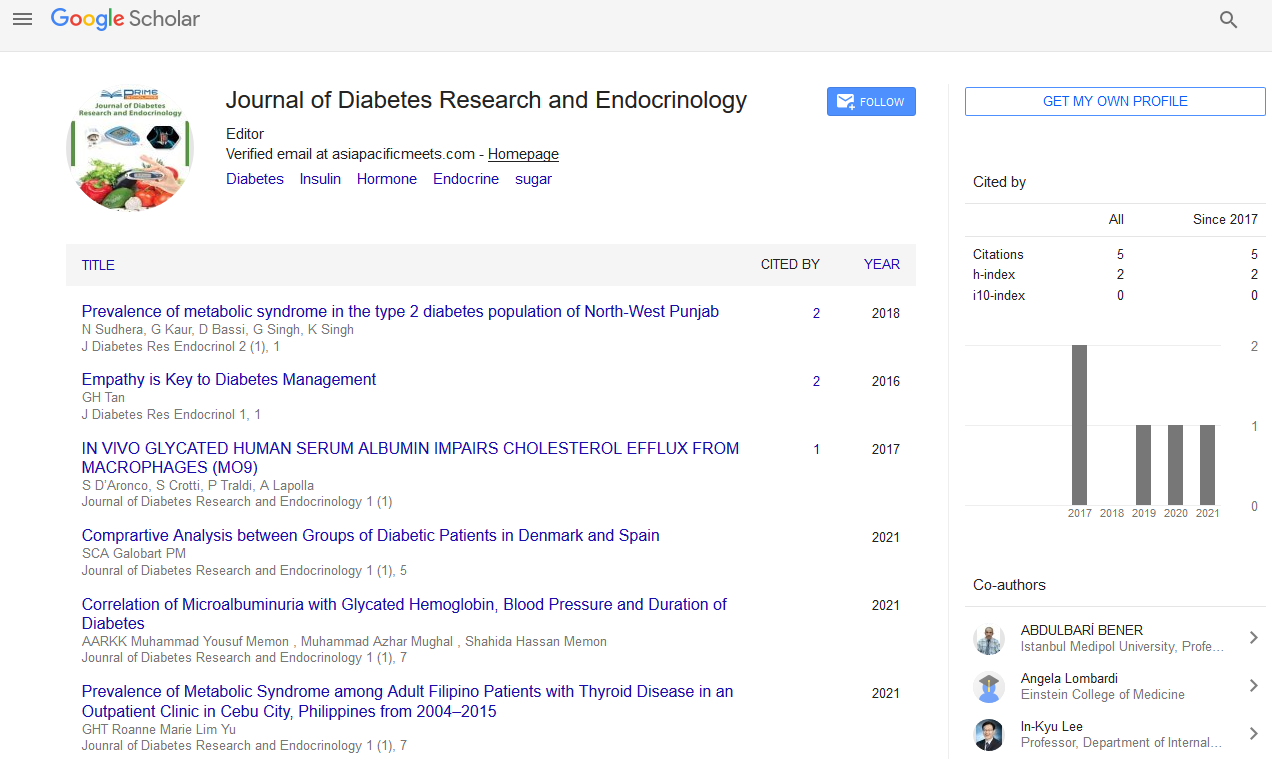Zhiguo Zara*
Department of Pharmacology, University of Louisville, Louisville, USA
- *Corresponding Author:
- Zhiguo Zara
Department of Pharmacology,
University of Louisville,
Louisville,
USA,
E-mail: ZhiguoZara@edu.com
Received Date: July 05, 2021 Accepted Date: July 19, 2021 Published Date: July 26, 2021
Citation: Zara Z (2021) A Note on Type 1 Diabetes. J Diabetes Res Endocrinol. Vol.5 No.4:e003.
Description
Type 1 diabetes (T1D), recently known as adolescent diabetes,
is an immune system infection that is a type of diabetes wherein
very little or no insulin is created by the islets of Langerhans
(containing beta cells) in the pancreas. Insulin is a chemical
needed for the cells to utilize glucose for energy and it manages
typical glucose levels in the circulation system. Before treatment
this outcomes in high glucose levels in the body. The normal side
effects are successive pee, expanded thirst, expanded craving,
and weight reduction. Extra side effects might incorporate foggy
vision, sluggishness, and slow twisted recuperating.
Manifestations regularly create throughout a brief timeframe,
frequently only weeks. The reason for type 1 diabetes is
unknown, however it is accepted to include a blend of
hereditary and ecological factors. Risk factors incorporate having
a relative with the condition. The hidden system includes an
immune system annihilation of the insulin-creating beta cells in
the pancreas. Diabetes is analyzed by testing the degree of sugar
or glycated hemoglobin (HbA1C) in the blood. Type 1 diabetes
can be recognized from type 2 by testing for the presence of
autoantibodies.
There is no realized method to forestall type 1 diabetes.
Treatment with insulin is needed for survival.Insulin treatment is
typically given by infusion simply under the skin however can likewise be conveyed by an insulin pump. A diabetic eating regimen and exercise are significant pieces of management. If
left untreated, diabetes can cause numerous
complications.Complications of somewhat fast beginning
incorporate diabetic ketoacidosis and nonketotic hyperosmolar
coma.Long-term entanglements incorporate coronary illness,
stroke, kidney disappointment, foot ulcers and harm to the eyes.
Furthermore, since insulin brings down glucose levels,
inconveniences might emerge from low glucose if inordinate measure of insulin is taken than needed. Type 1 diabetes makes
up an expected 5–10% of all diabetes cases. The quantity of
individuals influenced internationally is obscure, in spite of the
fact that it is assessed that around 80,000 kids foster the
sickness every year. Inside the United States the quantity of
individuals influenced is assessed at one to 3,000,000. Paces of
infection differ generally, with roughly one new case for every
100,000 every year in East Asia and Latin America and around 30
new cases for each 100,000 every year in Scandinavia and
Kuwait. It ordinarily starts in kids and youthful grown-ups.
Type 1 diabetes starts unexpectedly, normally in youth or preadulthood.
The significant indication of type 1 diabetes is
extremely high glucose, which normally shows in kids as a couple of days to long stretches of polyuria,polydipsia, and weight reduction. Now and then youngsters can be likewise encounter expanded craving,obscured vision,bedwetting,intermittent skin contaminations,candidiasis of the perineum,crabbiness, and execution issues at school. Adults with type 1 diabetes will in general have more fluctuated
manifestations
that come on over months instead of days to weeks.
Drawn out absence of insulin can likewise bring about diabetic
ketoacidosis, described by steady exhaustion, dry or flushed
skin, stomach agony, queasiness or regurgitating, disarray,
inconvenience breathing, and a fruity breath smell. Blood and
pee tests uncover strangely high glucose and ketones in the
blood and pee. Untreated ketoacidosis can quickly advance to
loss of cognizance, unconsciousness, and death. The level of kids
whose type 1 diabetes starts with a scene of diabetic
ketoacidosis fluctuates broadly by geology, as low as 15% in
pieces of Europe and North America, and as high as 80% in the
creating scene

